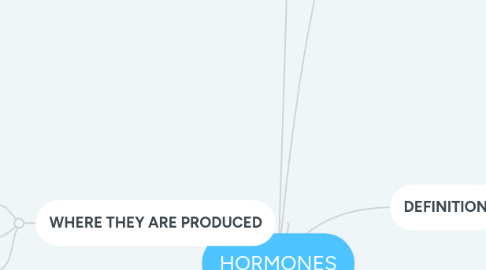
1. WHERE THEY ARE PRODUCED
1.1. Produced by exocrine glands.
1.1.1. Transported out by ducts or tubes
1.2. Produced by ductless glands, or endocrine glands.
1.2.1. Secreted directly into the bloodstream.
1.3. Some glands produce purely hormones, others produce a solution of hormones and other components.
2. ENDOCRINE GLANDS
2.1. HYPOTHALAMUS
2.1.1. regulates the secretion of some pituitary hormones
2.2. ADRENAL GLAND (MEDULLA)
2.2.1. Secretes adrenaline
2.2.1.1. Adrenaline had wide-ranging effects on the body
2.3. OVARY (FEMALES)
2.3.1. Secretes oestrogen and progesterone
2.4. PITUITARY GLAND
2.4.1. Plays an important role as a controller
2.4.2. Secretes a number of hormones which control secretion of hormones of some other endocrine glands
2.4.3. Secretes anyidiuretic
2.5. TESTIS (MALE)
2.5.1. Secretes testosterone
2.6. PANCREAS
2.6.1. Islets of Langerhans secrete insulin and glucagon
3. EFFECTS OF SOME HORMONES
3.1. EFFECTS OF INSULIN
3.1.1. Islets of Langerhans in the pancreas increase secretion of insulin
3.1.1.1. When the concentration of blood glucose increases above normal levels
3.1.2. Insulin promotes utilization of glucose by the cells.
3.1.3. LACK OF SECRETION
3.1.3.1. Glucose cannot be stored or utilized by tissue cells, hence blood glucose concentration rises.
3.1.3.1.1. Glucose is lost in urine
3.1.3.1.2. Leads to diabetes mellitus
3.1.3.2. Muscle cells have no glycogen reserves; body grows weak and continuously loses weight
3.1.3.3. Body oxidises fats instead of glucose for energy, resulting in production of poisonous substances, ketones, in urine
3.1.4. NORMAL
3.1.4.1. decreases blood glucose concentration by:
3.1.4.1.1. Increasing permeability of cell membranes to glucose
3.1.4.1.2. Stimulates liver and muscle cells to convert glucose into glycogen for storage.
3.1.4.1.3. Increase of oxidisation of glucose during tissue respiration.
3.1.5. OVERSECRETION
3.1.5.1. Abnormal drop in blood glucose concentration
3.1.5.1.1. Resulting in shock
3.1.6. diabetes mellitus
3.1.6.1. Disease where the body is unable to control blood glucose concentration to have it in its normal limits.
3.1.6.1.1. Blood glucose concentration rises to a level exceeding kidney's ability to completely reabsorb all the glucose, and this glucose is excreted in urine
3.1.6.2. TYPE 1
3.1.6.2.1. develops early on in the person's life.
3.1.6.2.2. Islets of Langerhans unable to produce or secrete enough insulin.
3.1.6.3. TYPE 2
3.1.6.3.1. Develops later on in life.
3.1.6.3.2. Overweight people more at risk
3.1.6.3.3. Develops when the cells do not respond well to the insulin.
3.1.6.4. SIGNS OF IT
3.1.6.4.1. persistently high blood glucose level.
3.1.6.4.2. Presence of glucose in urine after a meal
3.1.6.4.3. Slow healing of wounds.
3.1.6.5. TREATMENT
3.1.6.5.1. Diabetics must measure blood glucose concentrations and have urine tests regularly.
3.1.6.5.2. Watch diet carefully, avoid too many carbohydrates.
3.1.6.5.3. TYPE 1 DIABETES
3.1.6.5.4. TYPE 2 DIABETES
3.1.7. EFFECTS OF GLUCOGEN
3.1.7.1. Islets of Langerhans increase the secretion of hormone glucagon when the concentration of glucose is below normal levels.
3.1.7.2. Main target of glucagon is the liver
3.1.7.3. Glucagon increases blood glucose concentration by
3.1.7.3.1. Conversion of glycogen into glucose
3.1.7.3.2. New node
3.2. EFFECTS OF ADRENALINE
3.2.1. secreted by the adrenal medulla
3.2.1.1. triggered by being afraid, angry, anxious, stressed (stimuli from the brain)
3.2.1.2. adrenaline prepares body for "fight or flight" or for emergencies
3.2.2. Stimulates liver to convert glycogen to glucose
3.2.2.1. More glucose available for muscle contraction.
3.2.3. Increases blood glucose level
3.2.4. Increases metabolic rat
3.2.4.1. More energy released in tissue respiration.
3.2.5. Increases rate and depth of ventilation
3.2.5.1. Increases the rate of uptake of oxygen by lungs.
3.2.6. Increases rate of heartbeat, rise in blood pressure
3.2.6.1. Allows oxygen and glucose to be carried faster to the muscles
3.2.7. Increases rate of blood clotting
3.2.8. Constricts arterioles to the gut
3.2.8.1. Decreases digestive activities
3.2.9. Constricts arterioles in skin
3.2.9.1. Causes paleness
3.2.9.2. More blood to the muscles
3.2.10. Dilate pupils to enhance vision
3.2.11. Contracts hair muscles
3.2.11.1. Produces goosebumps
3.2.11.2. Hair standing on end
4. WHAT THEY DO
4.1. Influence the growth, development and activity of an organism
4.2. Act as chemical messengers; help body respond, develop, work together smoothly.
5. DEFINITION
5.1. A chemical substance produced in minute quantities by an endocrine gland.
5.2. Transported into bloodstream to target organs where it exerts its effects.
5.3. Destroyed by the liver after performing functions.
6. CONTROL OF HORMONES PRODUCTION
6.1. production of hormones MUST be balanced.
6.1.1. The body requires an adequate amount of hormones to function smoothly
6.1.2. Excess production may be harmful.
6.2. Some endocrine glands have their production controlled by nervous system
6.3. Other endocrine glands are regulated by certain chemical substances
6.3.1. Eg. hormones from other endocrine glands.
7. ENDOCRINE VS NERVOUS CONTROLS
7.1. The endocrine system (like the nervous system) serves as a mean of coordination within our bodies.
7.1.1. Stimuli causes transmission of a message to a target organ which carries out the response
7.1.2. New node
7.1.3. New node
7.2. Nervous Control
7.3. Nervous control affects only parts of your.l body sometimes, localised.
7.4. NERVOUS CONTROL
7.4.1. Involves nerve impulses
7.4.2. Impulses are transmitted by neurones
7.4.3. Usually quick responses
7.4.4. Responses are short lived
7.4.5. New node
7.4.5.1. New node
7.4.6. New node
7.5. ENDOCRINE
7.5.1. Imvolves hormones
7.5.1.1. Usually localised
7.5.2. Hormones are transported. By the class
7.5.3. Usually slow responses
7.5.4. Responses may be short or long kived
7.5.5. Always involuntary
7.5.6. May affect more than one target orhan
